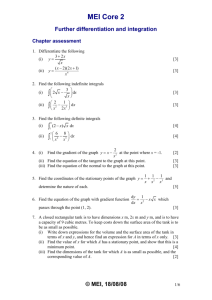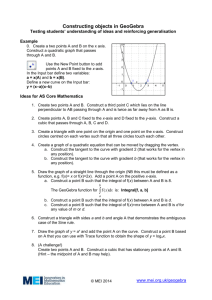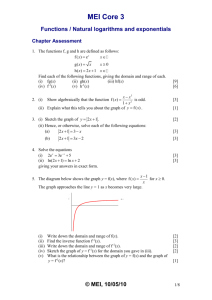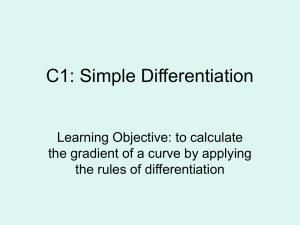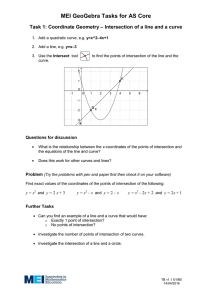Techniques for differentiation
advertisement
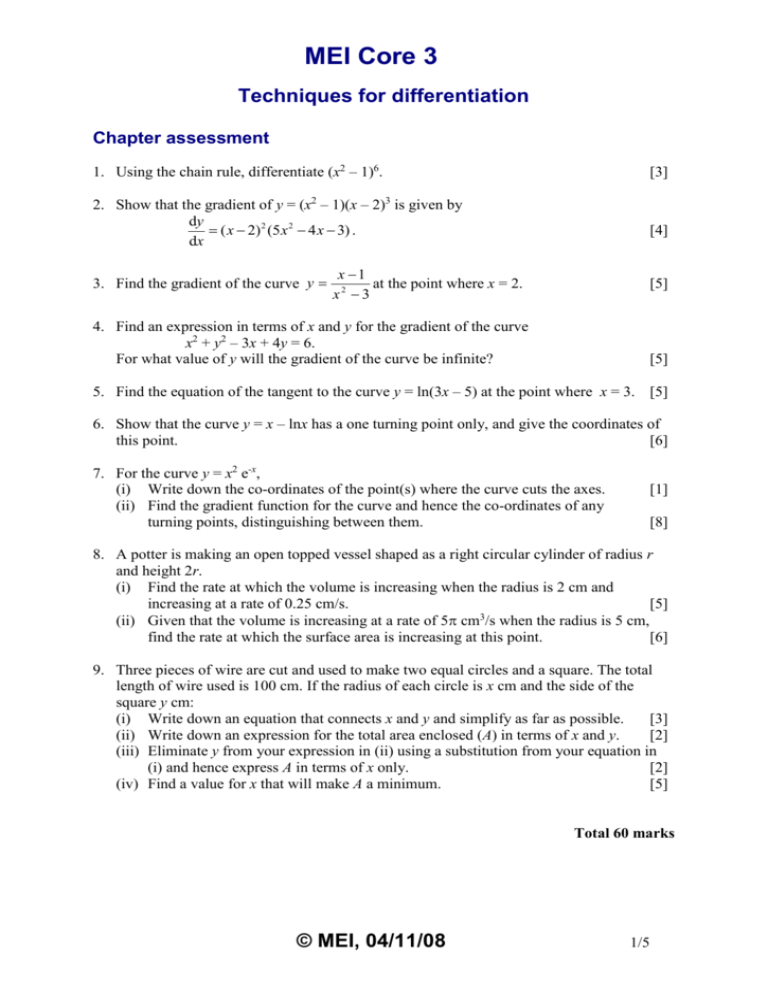
MEI Core 3 Techniques for differentiation Chapter assessment 1. Using the chain rule, differentiate (x2 – 1)6. [3] 2. Show that the gradient of y = (x2 – 1)(x – 2)3 is given by dy ( x 2) 2 (5 x 2 4 x 3) . dx 3. Find the gradient of the curve y [4] x 1 at the point where x = 2. x2 3 [5] 4. Find an expression in terms of x and y for the gradient of the curve x2 + y2 – 3x + 4y = 6. For what value of y will the gradient of the curve be infinite? [5] 5. Find the equation of the tangent to the curve y = ln(3x – 5) at the point where x = 3. [5] 6. Show that the curve y = x – lnx has a one turning point only, and give the coordinates of this point. [6] 7. For the curve y = x2 e-x, (i) Write down the co-ordinates of the point(s) where the curve cuts the axes. (ii) Find the gradient function for the curve and hence the co-ordinates of any turning points, distinguishing between them. [1] [8] 8. A potter is making an open topped vessel shaped as a right circular cylinder of radius r and height 2r. (i) Find the rate at which the volume is increasing when the radius is 2 cm and increasing at a rate of 0.25 cm/s. [5] 3 (ii) Given that the volume is increasing at a rate of 5 cm /s when the radius is 5 cm, find the rate at which the surface area is increasing at this point. [6] 9. Three pieces of wire are cut and used to make two equal circles and a square. The total length of wire used is 100 cm. If the radius of each circle is x cm and the side of the square y cm: (i) Write down an equation that connects x and y and simplify as far as possible. [3] (ii) Write down an expression for the total area enclosed (A) in terms of x and y. [2] (iii) Eliminate y from your expression in (ii) using a substitution from your equation in (i) and hence express A in terms of x only. [2] (iv) Find a value for x that will make A a minimum. [5] Total 60 marks © MEI, 04/11/08 1/5 MEI C3 Differentiation Assessment solutions Techniques for differentiation Solutions to chapter assessment 1. y ( x 2 1)6 Let u x 2 1 y u6 dy du du 2x dx 6u 5 Using the chain rule: dy dy du 6u 5 2 x dx du dx 12 x( x 2 1)5 [3] 2. y ( x 2 1)( x 2)3 du 2x Let u x 2 1 dx dv 3( x 2)2 Let v ( x 2)3 dx dy dv du Using the product rule: u v dx dx dx 2 ( x 1) 3( x 2)2 ( x 2)3 2 x ( x 2)2 3( x 2 1) 2 x( x 2) ( x 2)2(3 x 2 3 2 x 2 4 x ) ( x 2)2(5 x 2 4 x 3) 3. y [4] x 1 x2 3 du 1 dx dv 2x Let v x 2 3 dx Let u x 1 Using the quotient rule: dy dx v du dv u dx dx v2 ( x 2 3) 1 ( x 1) 2 x ( x 2 3)2 x2 3 2x2 2x ( x 2 3)2 x 2 3 2 x ( x 2 3)2 © MEI, 04/11/08 2/5 MEI C3 Differentiation Assessment solutions 2 2 3 2 2 4 3 4 3 . When x = 2, gradient (2 2 3)2 12 [5] 4. x 2 y 2 3 x 4 y 6 2x 2y Differentiating implicitly: (2 y 4) dy dx dy 34 dy dx 0 3 2x dx dy 3 2 x dx 2 y 4 The gradient will be infinite where 2 y 4 0 y 2 [5] 5. y ln(3 x 5 ) dy dx 1 3 3 3x 5 3x 5 3 3 33 5 4 When x = 3, y ln(3 3 5 ) ln 4 2 ln 2 Equation of tangent is y 2 ln 2 43 ( x 3) When x = 3, gradient 4 y 8 ln 2 3 x 9 4 y 3 x 8 ln 2 9 [5] 6. y x ln x dy dx 1 1 x At turning points, 1 1 1 x 0 1 x x 1 The only turning point is at x = 1. When x = 1, y 1 ln 1 1 0 1 The turning point is (1, 1). [6] 7. (i) y x 2 e x When x = 0, y = 0. The only point where the curve cuts the axes is (0, 0). © MEI, 04/11/08 [1] 3/5 MEI C3 Differentiation Assessment solutions du 2x dx dv e x Let v e x dx dy x 2 e x 2 xe x xe x (2 x ) Using the product rule, dx At turning points, xe x (2 x ) 0 (ii) Let u x 2 x 0 or x 2 When x = 0, y = 0 4 When x = 2, y 2 e dy x<0 -ve 0<x<2 +ve x>2 -ve dx 4 From table, (0, 0) is a minimum point and 2, 2 is a maximum point. e [8] 8. (i) V r 2h r 2 2r 2 r 3 dV 6 r 2 dr dV dV dr dr 6 r 2 dt dr dt dt dV dr 2 6 2 0.25 0.25 : When r 2 and dt dt 6 Using the chain rule: 18.8 cm 3 /s (3 s.f.) [5] (ii) Surface area A 2 rh r 2 2 r 2r r 2 4 r 2 r 2 dA 10 r dr 5r 2 dA dA dr dV dt dr dV dt 1 dV 5 dV 10 r 2 6 r dt 3r dt dA 5 5 dV 5 5 , When r 5 and dt 35 3 dt 2 5.24 cm /s (3 s.f.) Using the chain rule: [6] © MEI, 04/11/08 4/5 MEI C3 Differentiation Assessment solutions 9. (i) Wire used for square 4 y Wire used for each circle 2 x Total length is 100 cm 4 y 4 x 100 y x 25 [3] (ii) Area of square y 2 Area of each circle x 2 Total area is given by A y 2 2 x 2 [2] (iii)From (i), y 25 x Substituting into expression in (ii): A (25 x )2 2 x 2 [2] (iv)The expression for A is quadratic, with positive term in x², so the turning point is a minimum point. dA 2(25 x ) 4 x dx 2(25 x ) 4 x At stationary point, 2 (25 x ) 4 x 0 25 x 2 x 0 (2 )x 25 25 x 2 Therefore x 25 minimises the value of A. 2 © MEI, 04/11/08 [5] 5/5

